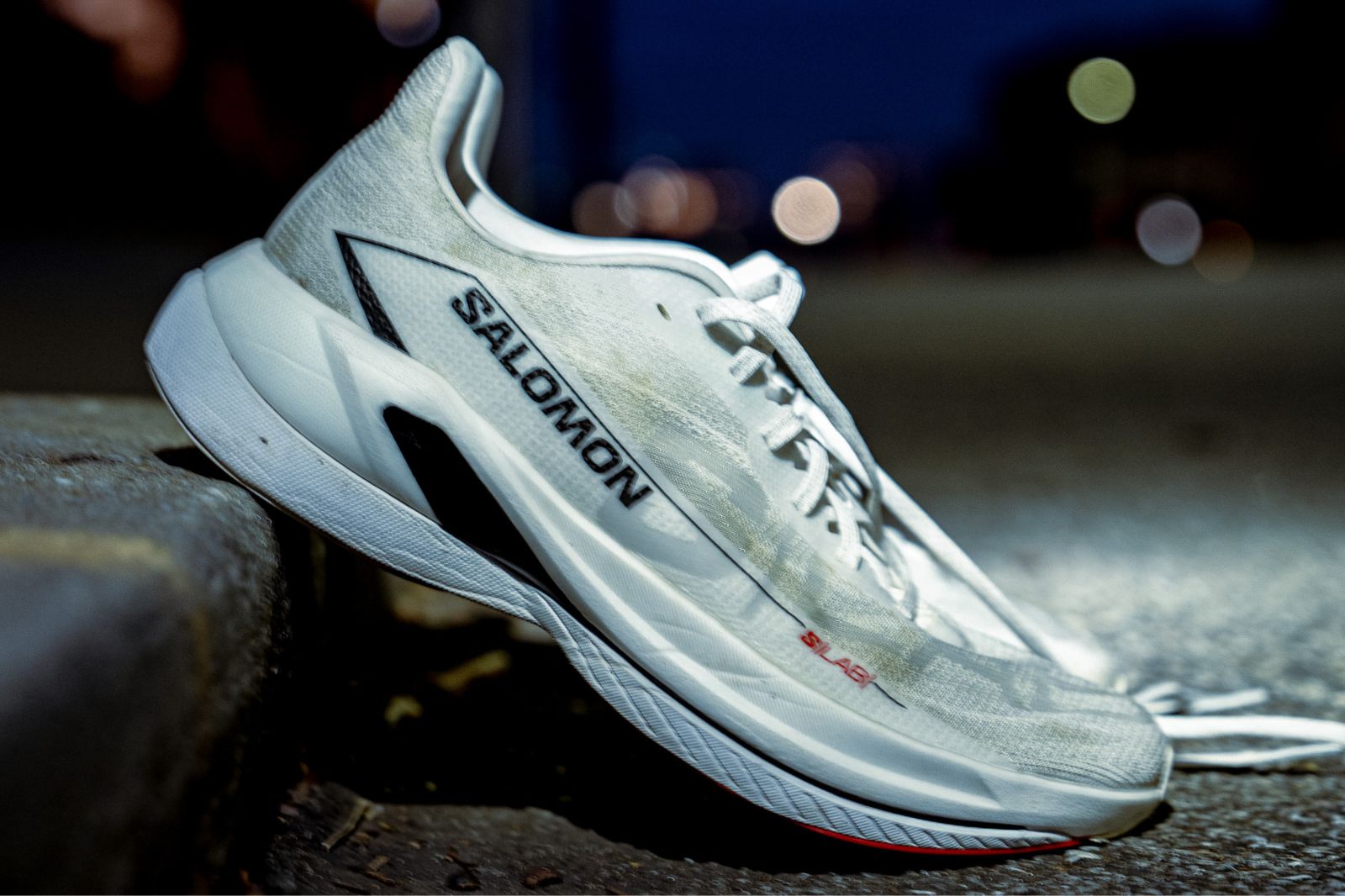
We independently review everything we recommend. When you buy through our links, we may earn a commission.
8.3 oz. (232 g) for a US M8.5 (unisex)
38 mm in heel, 30 mm in forefoot (8 mm drop)
Race day, uptempo training
Dual-density midsole (Peba Energy Foam+ on top, EVA Energy Foam on bottom), full-length winged carbon fiber plate
Available now, $220 (updated pricing)
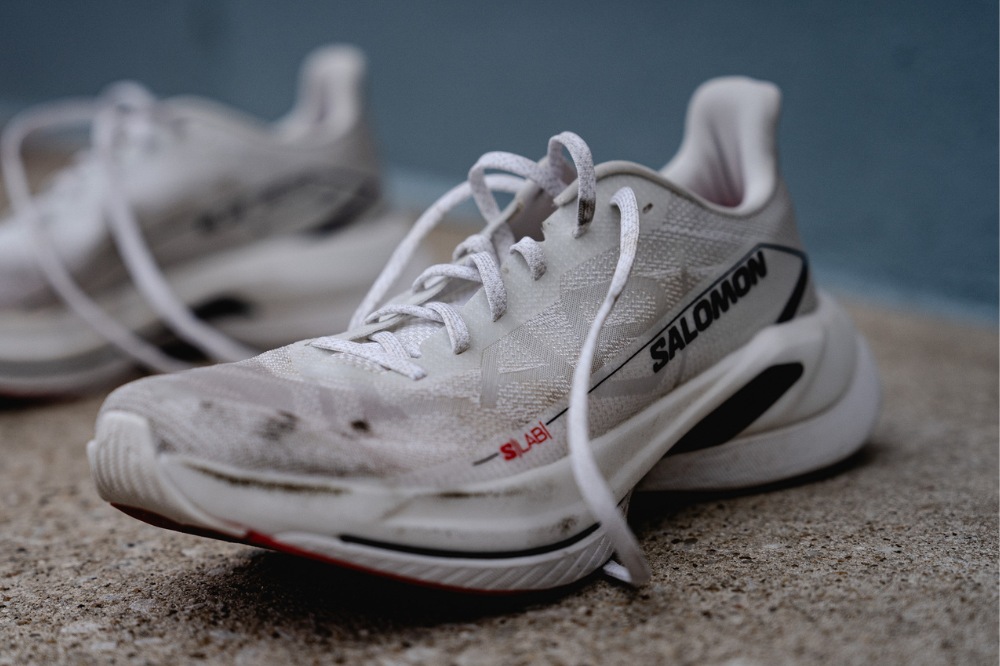
Designed for 3:30 and slower marathoners
THOMAS: For most of us, the time it takes to run a marathon is relative to our own personal experience. In that experience, it’s a mixture of things that get us towards our time goals. Some of it is training, some of it is nutrition, some of it is whether or not it’s just a good day or a bad day. Some of it is the shoes we wear on race day. Once we cross those finish lines, we then have a baseline of what is fast or slow.
Outside of our own bubbles, we can all agree that a 2:00:35 (the current world record for men) is a speedy marathon, but what is a fast or slow marathon time when looking at the whole of the distance?
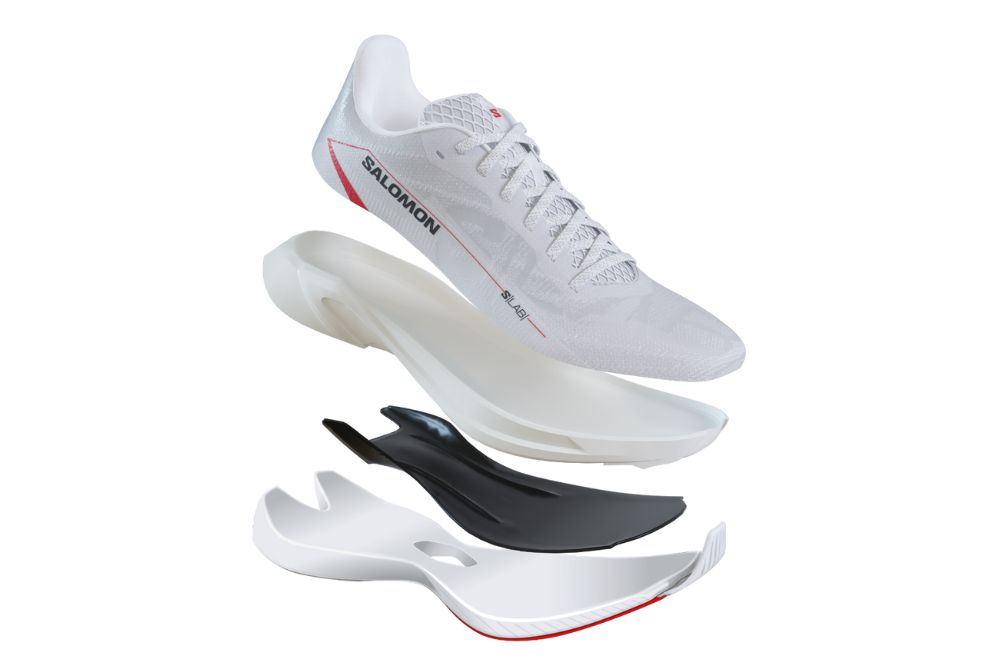
All the layers of the Salomon S/Lab Spectur
Global data compiled by RunRepeat shows that the average finishing time for a marathon is 4 hours and 32 minutes. Over double the time run by the world’s fastest marathoners. And yet we use the same shoes to run those times on race day.
Which begs the question: Should we all be running in shoes designed for the elite marathon racer?
Salomon doesn’t think so. According to Salomon, runners with an 8:03/mile pace or slower will benefit more from a shoe that uses the best materials for racing but is set up differently to maximize the efficiency of the slower cadence runner. Salomon describes the difference as this: the elite shoe is there to win the race, and the sub-elite shoe will win your race.
I’m a runner who aims to finish just under the 8-minute/mile pace, but I have run many marathons slower than that. Yet I would have difficulty choosing a non-elite race day shoe, even if I aimed for a 3:30 marathon. Who knows, what if everything aligns? What if I get a tailwind? What if the spirit of Kipchoge enters my body on race day? I want to have the best possible chance at running that sub-2-hour marathon, whatever that means to me. My guess is other runners might feel the same.
The Salomon S/Lab Spectur uses all the same quality parts that their S/Lab Phantasm utilizes, including the same Peba-based EnergyFoam+ midsole and carbon composite plate material in the EnergyBlade. The shoe design creates a more stable heel, and the plate shape adds stability and propulsion. Salomon points out that the 3:30+ marathoner is on their feet over 50% longer than elite athletes and that the S/Lab Spectur, with its R-Camber shaped midsole, will benefit the runner whose ground contact is over an hour longer.
We haven’t run a marathon in the shoe, but we can tell you our thoughts from what we were able to experience.
The S/Lab Spectur has an 8 mm differential with 38 mm in the heel and 30 mm in the toe. My USA size 10.5 weighs 9.4 oz/268 grams.
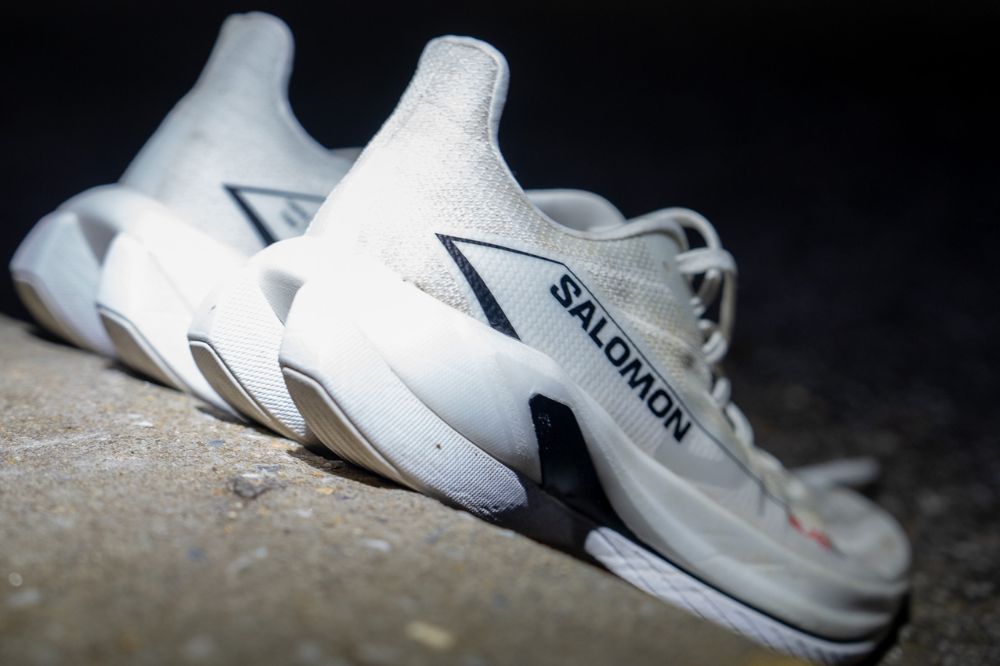
ROBBE: Whenever I hear about shoes designed specifically for a certain subset of runners, I instinctually raise a skeptical eyebrow. Women-specific shoes? We’ve yet to find one that doesn’t suck. Stability shoes? For years they were overbuilt and gimmicky. Racing shoes to make slower runners faster than the fastest racing shoes? I guess that’s where we are now with the Salomon S/Lab Spectur.
It doesn’t help my skepticism that Salomon has been mediocre-at-best on the road side of things, from the RA series to a handful of models on the shelves today. But there was a signal of good things to come, especially with the addition of their elite race day shoe in the Salomon S/Lab Phantasm 2. That shoe– with a Peba midsole, carbon fiber plate, and excellent upper fit– can go toe-to-toe with most of the elite models on the market. Which gave me hope for the S/Lab Spectur.
This is a shoe that is essentially designed for myself, a 3:30 marathoner if there ever was one. But as Thomas said– when I lay out my kit the night before a race, will I have the faith, confidence, and trust to run in a non-elite shoe on race day? And when I cross that finish line after 26.2 miles on the course, will it have done its job in handing me a shiny new PR?
That’s the question.
Shop The Shoe - UnisexTHOMAS: When we received the S/Lab Spectur for review, I did not have high hopes for the shoe. I hadn’t run in a Salomon road shoe that I enjoyed before. The S/Lab Spectur looked complicated, with two foams and a winged plate. Typically, simpler is better. Salomon has some decent road shoes, but they haven’t mastered a daily trainer yet. However, from my first run in the S/Lab Spectur, I was impressed with the smooth, supportive feel. The simple lacing made the well-fitting upper easy to lock your foot into place. I had no issues with rubbing or heel lift.
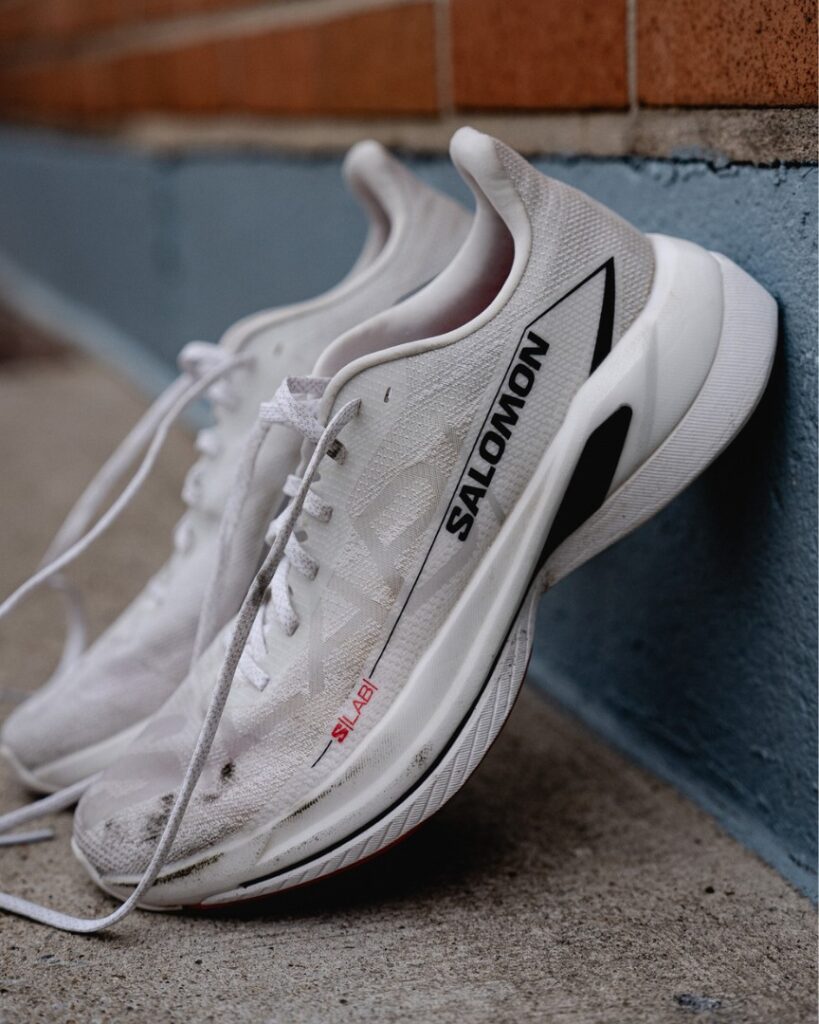
Winged carbon-infused EnergyBlade
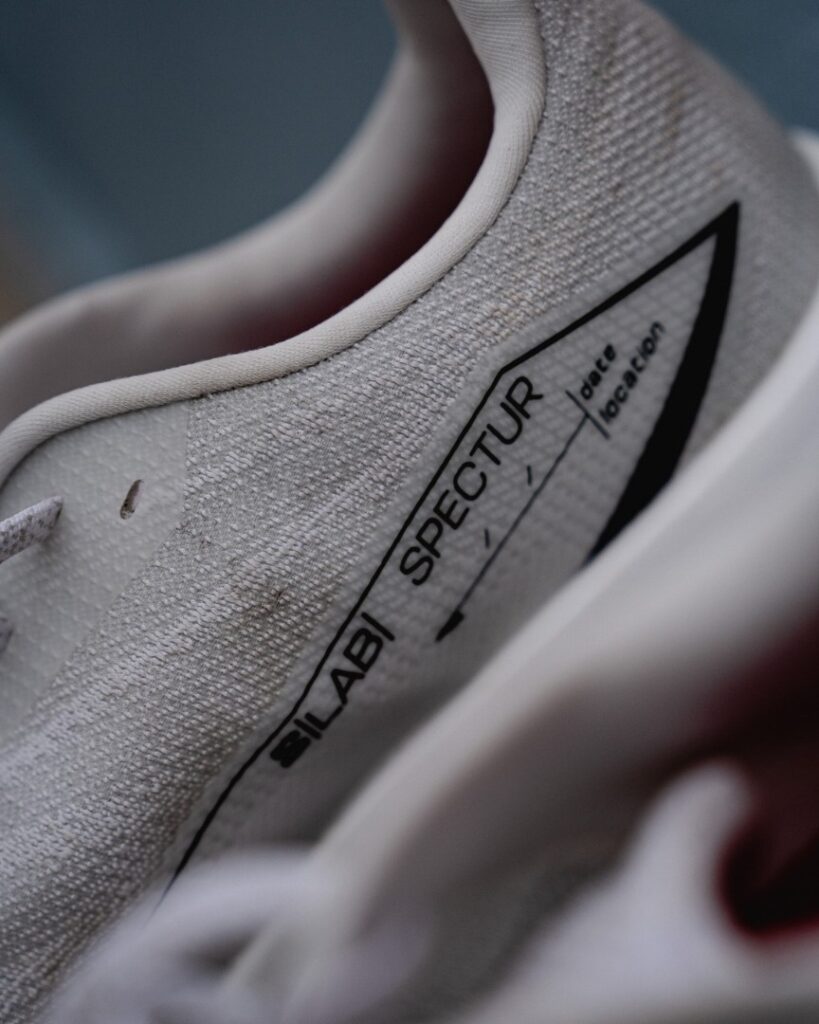
Date and location of your race
The midsole and stable heel are the stars of the show. The Peba-based midsole sits close to the foot and has the bounce you expect from a race day foam. The full-length carbon composite plate has wings extending up the shoe’s lateral and medial sides. The plate does an excellent job of adding stability and propulsion. The shoe narrows in the throat, but the heel and forefoot are broad with an R-Camber shape, creating an exceptionally smooth ride. With the beefier EnergyFoam and full-coverage rubber finishing off the last two layers of the shoe, the S/Lab Spectur is durable enough to train and race in.
Once I started running in the S/Lab Spectur, I didn’t want to take them off, and for a while, they were the only shoes I was grabbing to get all my miles. The shoe is a little narrow and fits my foot perfectly. Once you find your pace in the shoe, the S/Lab Spectur rolls through the stride.
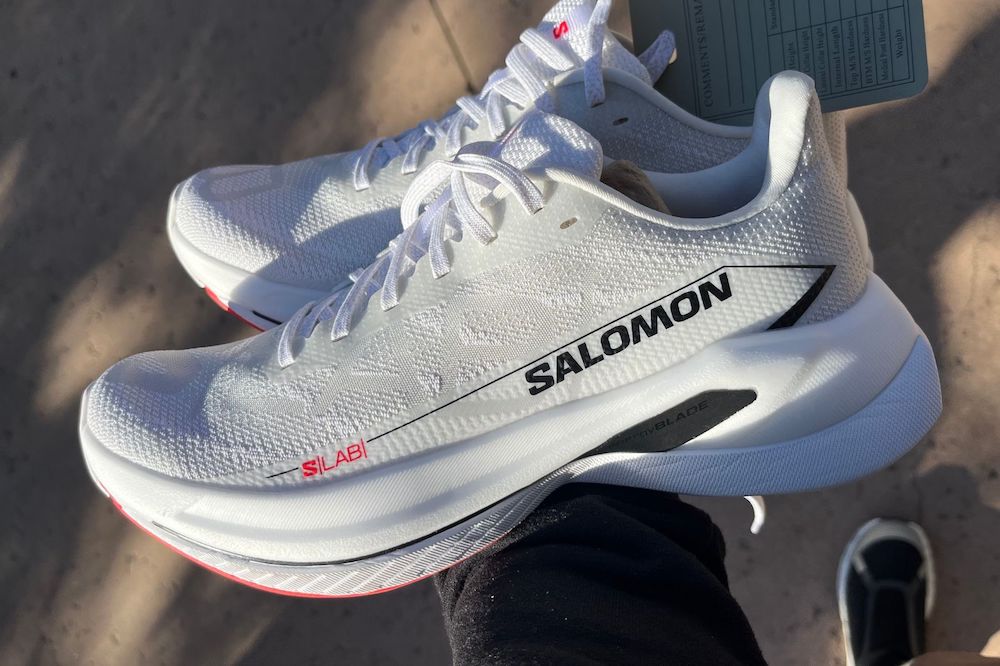
ROBBE: I’ll start out with looks since that’s what you did when you chose your current and/or forever life partner. It’s a lovely shoe to look at. The all-white with black and red accents is lean and clean and what you look for in a racing machine. I especially like the sculpting through the midsole and heel. It’s not as beautiful as the Phantasm 2, but it’s pretty close. I also appreciate the race, date, and time slots on the medial side of the shoe for whenever you break that PR.
I absolutely love the upper on this shoe. For a race day shoe, it has to be one of the most comfortable uppers out there, while still retaining a decent level of breathability. The lockdown is second-to-none without any lace pressure or movement in the shoe. No heel slippage either, which can sometimes be a problem with plated shoes. It just feels great.
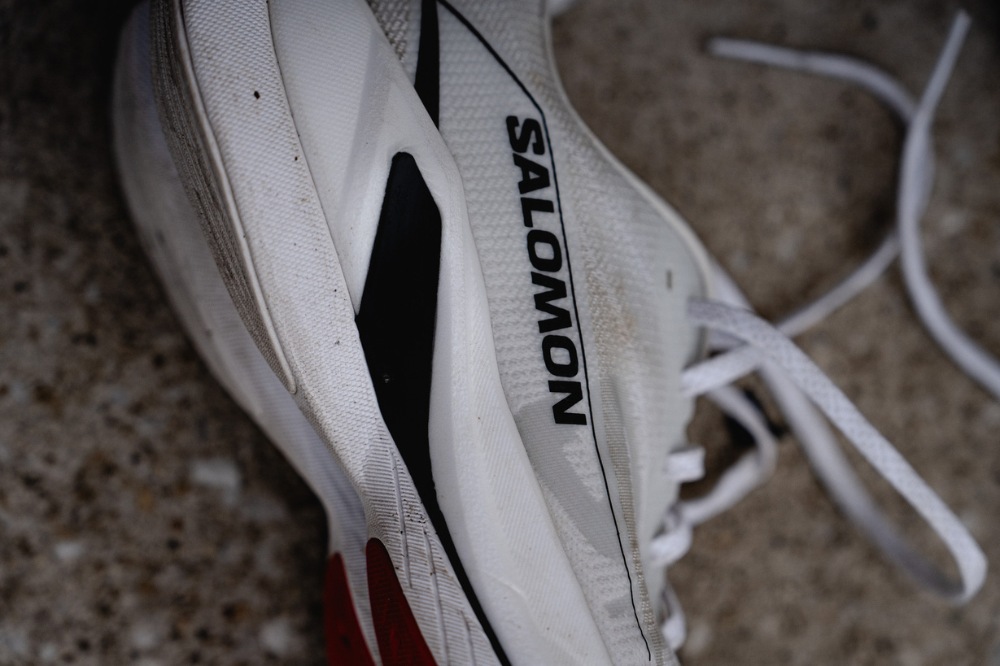
On the run, I was really surprised how much I loved this shoe. Again, my expectations were far from what this shoe delivered. It’s rare to get a shoe that feels different, but this was one of them. It’s not the huge bounce and energy return you get from shoes like the Alphafly 3 or Adios Pro 3, but it’s also not as muted as some of the super shoes. Instead, it’s somewhere in between.
On landing you first feel that Peba squish, which levels out once you hit that bottom layer of EVA. At the same time, the winged plate provides a truly unique experience, giving you some leverage and propulsion but also keeping you centered over the platform. I really loved that sensation.
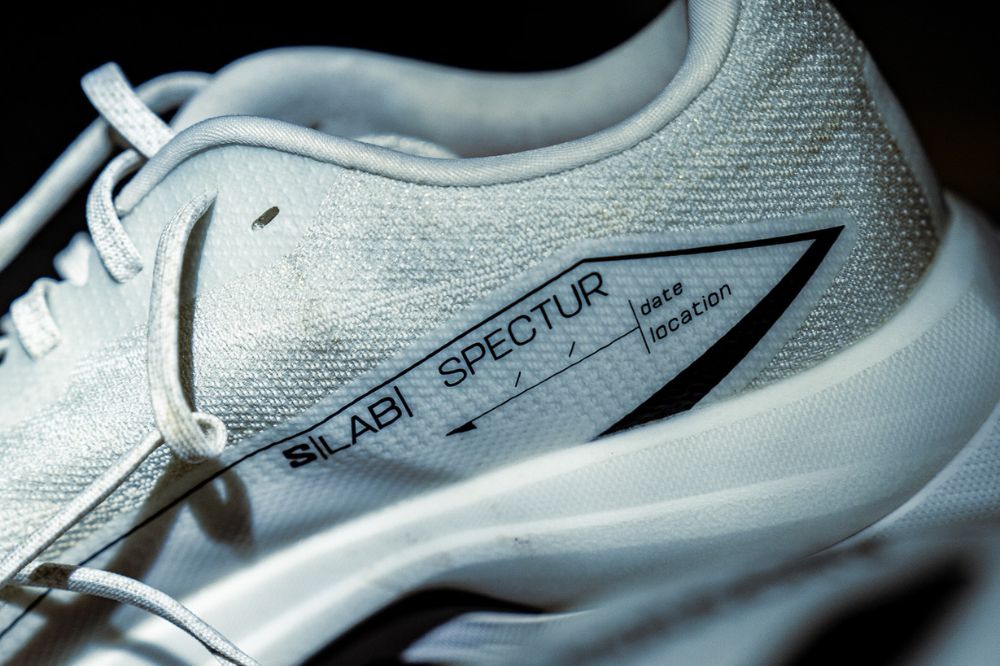
Record your PRs
Miles in this shoe are effortless and it feels like the best kind of shoe that may or may not be a race day shoe. It’s hard to categorize it because it has elements of both race day and training days and they’re all great. It isn’t as racer-like as the top-tier elite shoes, but it’s also not as conservative as the $180-and-under family. With a high stack of foam it still offers plenty of cushion in the heel and throughout the midfoot, though it seems a little bit firmer in the forefoot. Not harsh in any way, just not super soft.
The Contagrip outsole is plenty grippy and should offer a ton of durability over the long haul.
As far as weight, it’s one of the heaviest race day shoes on the market, but I didn’t find it to be excessive underfoot. Salomon says this shoe is 8.3 ounces for a size 8.5 in the U.S. That’s not terribly far off from some other race day shoes like the Nike Alphafly 2, and even at that weight, it’s not super noticeable.
Salomon says that’s part of the whole thing– you need more comfort and support when running 3:30 or longer for the marathon. I’m not saying I don’t love an ultra lightweight shoe, but a nice upper doesn’t never not feel bad. It’s definitely a shoe that can be worn at any pace, which can’t be said for many race day shoes out there.
Long story short, I found myself wanting to wear this shoe all the time.
Shop The Shoe - UnisexTHOMAS: The tongue seems like an afterthought. I would love to see it integrated into the upper better. Every time you put the shoe on, you must adjust the tongue to keep it from folding. For race day, the weight is an issue. The shoe’s weight spoils Salomon’s solutions for the slower runner’s needs.
Salomon must find a way to knock an ounce and a half off the shoe for it to be viable for the runner going 4 hours or less in the marathon. Finally, the shoe will retail for $250 (editor’s note: it’s now $220). While that is the going rate for most carbon-plated racers, I enjoyed the shoe as a do-it-all daily trainer. That price makes the S/Lab Spectur a costly daily option.
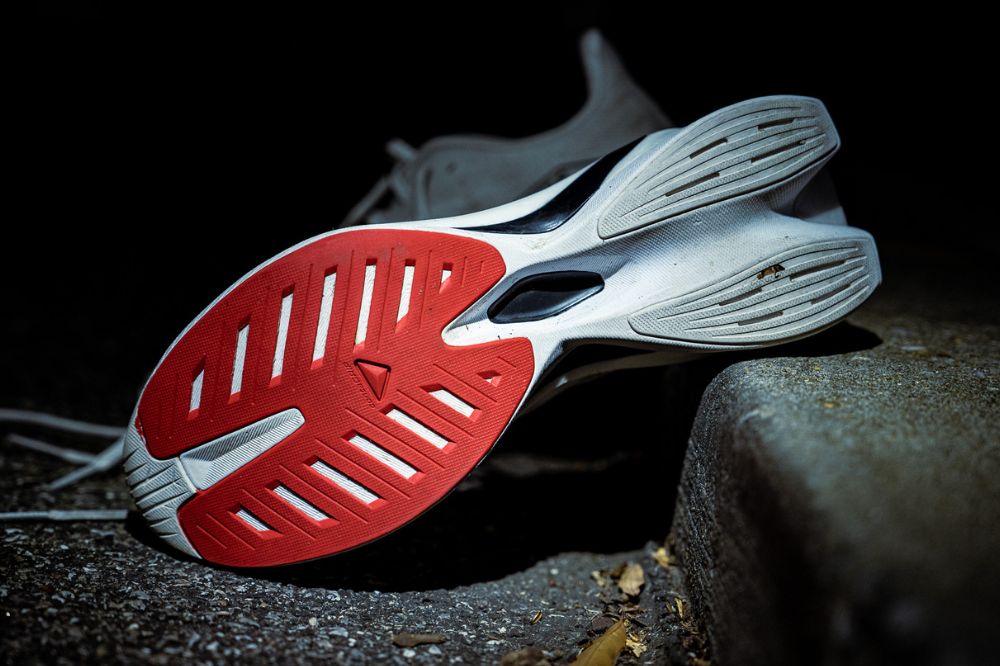
Contagrip outsole provides solid traction
ROBBE: This may be our job as reviewers in some capacity, but I’m struggling to see how Salomon can convince the general public that a heavier, more built up shoe that lacks the firepower of shoes like the Alphafly will deliver your fastest, race day performance. Especially when the price point remains almost the same ($250). You can tell me you have all the data in the world, but I can tell you that the first impressions on foot are a whole lot different.
What it comes down to is this: I have to trust Salomon that this is the best shoe for me, since I can’t verify it until I actually run a marathon. And most runners only do that twice a year.
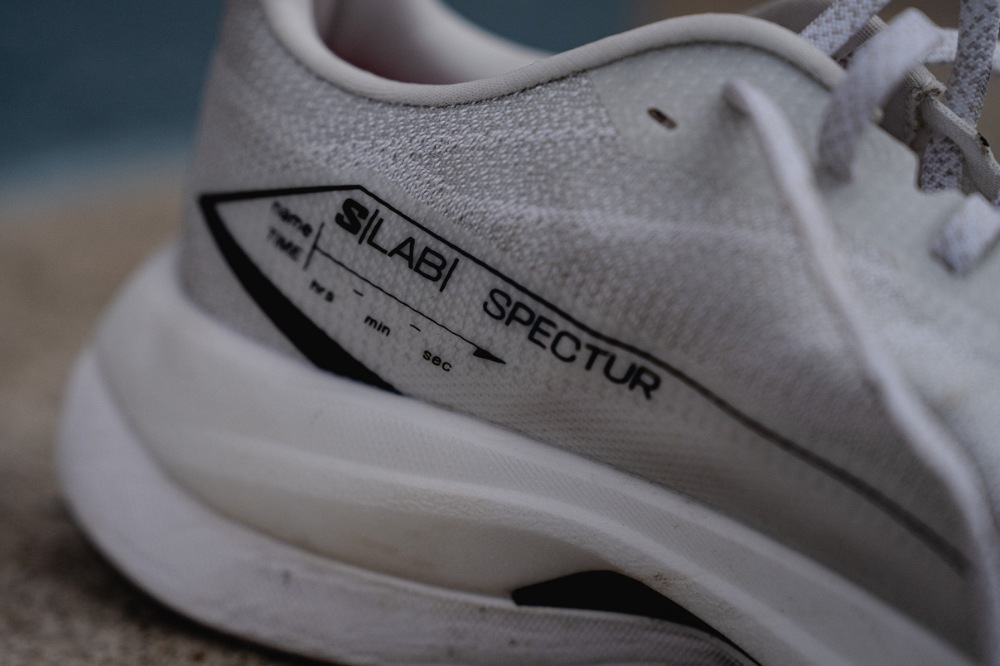
Record your name and time
I’m not saying they’re not right. After all, it makes sense that a runner who is out on the course longer should have more support without sacrificing some of those premium components like a carbon plate and top layer of Peba. But I’ve run in the Nike Alphafly 3 and the Hoka Rocket X 2 and the Adidas Adios Pro 3 and the Salomon S/Lab Phantasm 2. Those shoes feel like actual rockets.
That’s not saying this shoe doesn’t feel great– it does indeed. However, as Thomas said, it doesn’t feel “fast fast.” It can be fast, but it feels like that’s your job, while the shoe’s job is to keep you comfortable. Whereas, the elite racing shoes feel like thoroughbreds out of the gate, and you’re just along for the ride. The flip side to those, however, is that if you’re not in tip-top race shape, you may start to break down after a couple hours of abuse.
Last thing– Salomon, your naming conventions are more confusing than the rules of cricket written in Mandarin. There is a shoe called the Salomon Spectur– this is not that shoe. S/Lab denotes the performance line of Salomon, so if you surprisingly see this shoe on sale for $160, you’re probably looking at the standard version of it.
Shop The Shoe - UnisexTHOMAS: This shoe is one of my all-time favorites but wouldn’t be my choice for race day. I train for sub-3:30 marathons, but believe me, I have run a lot of my marathons above 3:30. I would be the ideal candidate for this shoe. Weight plays a significant role in fatigue during a marathon. The S/Lab Spectur is too heavy to feel fast underfoot. I found myself cruising in the shoe but not feeling fast. When I throw on other race-day shoes, it can be hard to go “easy.” In the S/Lab Spectur, a steady rhythm was easy to fall into; turning it up was more challenging.
I want to feel like I have a shot at something special when I line up on race day. Having a shoe designed for non-elite athletes is like psychologically putting a restrictor plate on my foot, even though it might be the better choice. I would need to do lab testing to prove that this is a better option. With all of that said, the shoe is terrific, and if you’re intimidated by super shoes, this shoe could be a perfect option. Certainly better than running in a standard daily trainer. If this shoe were $180 and marketed as a super trainer, it would be my choice over many other shoes in the category.
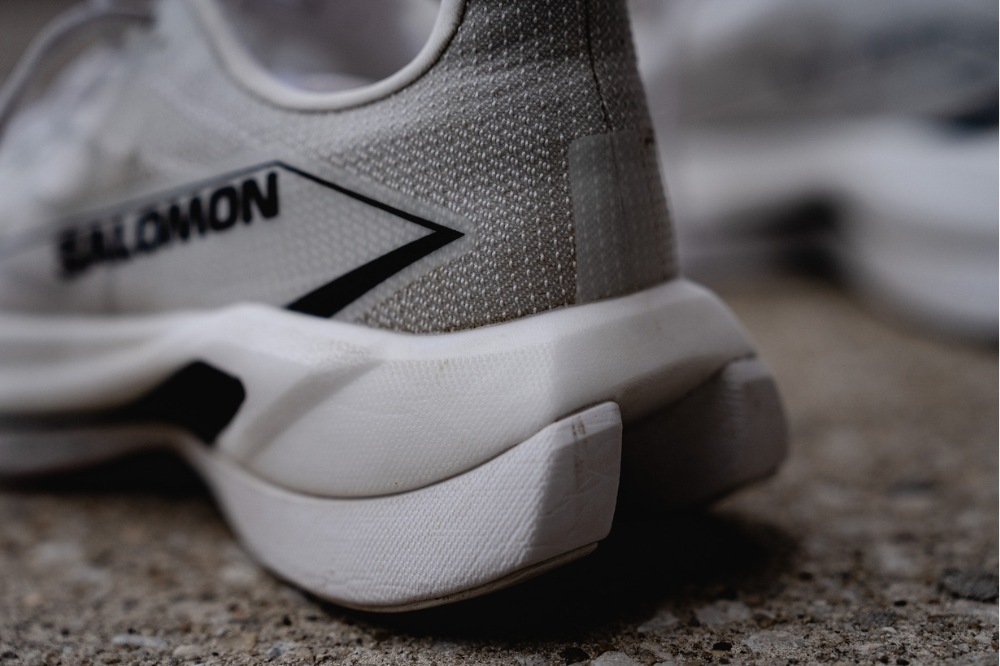
Split heel segment
ROBBE: For sure, this is the best road shoe Salomon has ever produced and maybe one of the best overall shoes we’ve tried over the last year. It’s really, really nice. However, having run in other elite shoes in the same price range, and having a penchant for risk and crashing and burning, I’d have a hard time lacing this up for race day. My point is this: When you’ve worn shoes that make you feel like you’re cheating, it’s hard to go back to anything less.
That said, if you are a 4-hour-plus marathoner or a first time marathoner (which indeed are the majority of runners), I think you should seriously consider this shoe. It’ll give you everything you need without sacrificing some of those special elements that we all want in a race day shoe.
Lastly, stay tuned for a future review from BITR reviewer Seth Epley, who will be racing in the shoe at the 2024 Houston Marathon.
Shop the Salomon S/Lab Spectur now for $220.
Shop The Shoe - UnisexEditor’s note: The original version of this review noted that the shoe would retail for $250. Salomon has since lowered the price point. It will now be available for $220.
Want to learn more about how our review process works? Check out this guide.
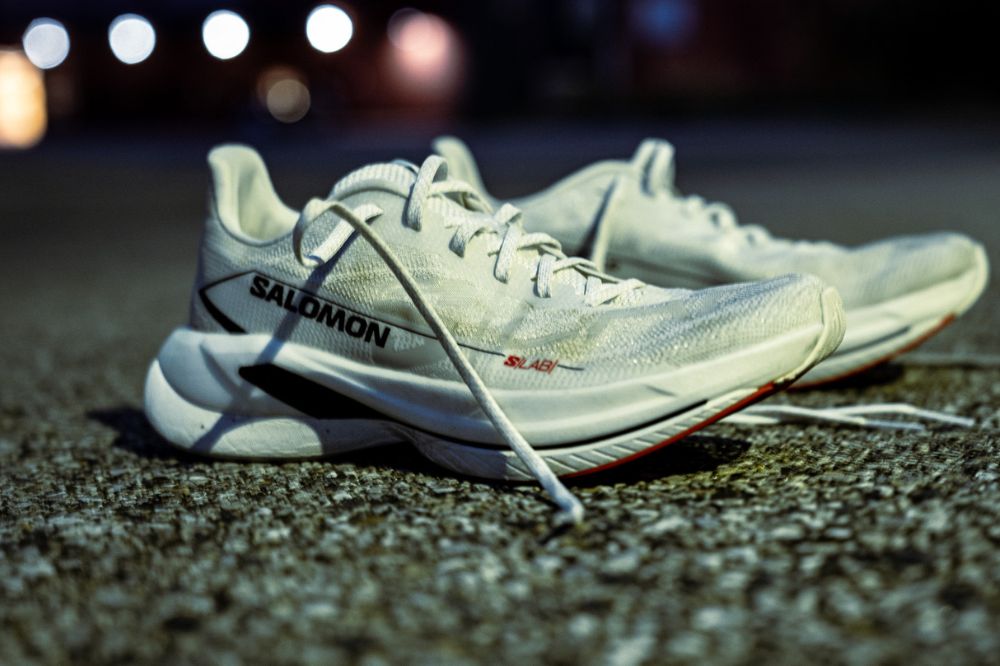
Have something to say? Leave a Comment

As the founder of Believe in the Run, Thomas’s goal is to help runners pick the shoes and gear that will make their running experience the best that it can be.
More from Thomas
Robbe is the senior editor of Believe in the Run. He loves going on weird routes through Baltimore, finding trash on the ground, and running with the Faster Bastards. At home in the city, but country at heart. Loves his two boys more than anything. Has the weakest ankles in the game.
More from Robbe Read Article
Read Article
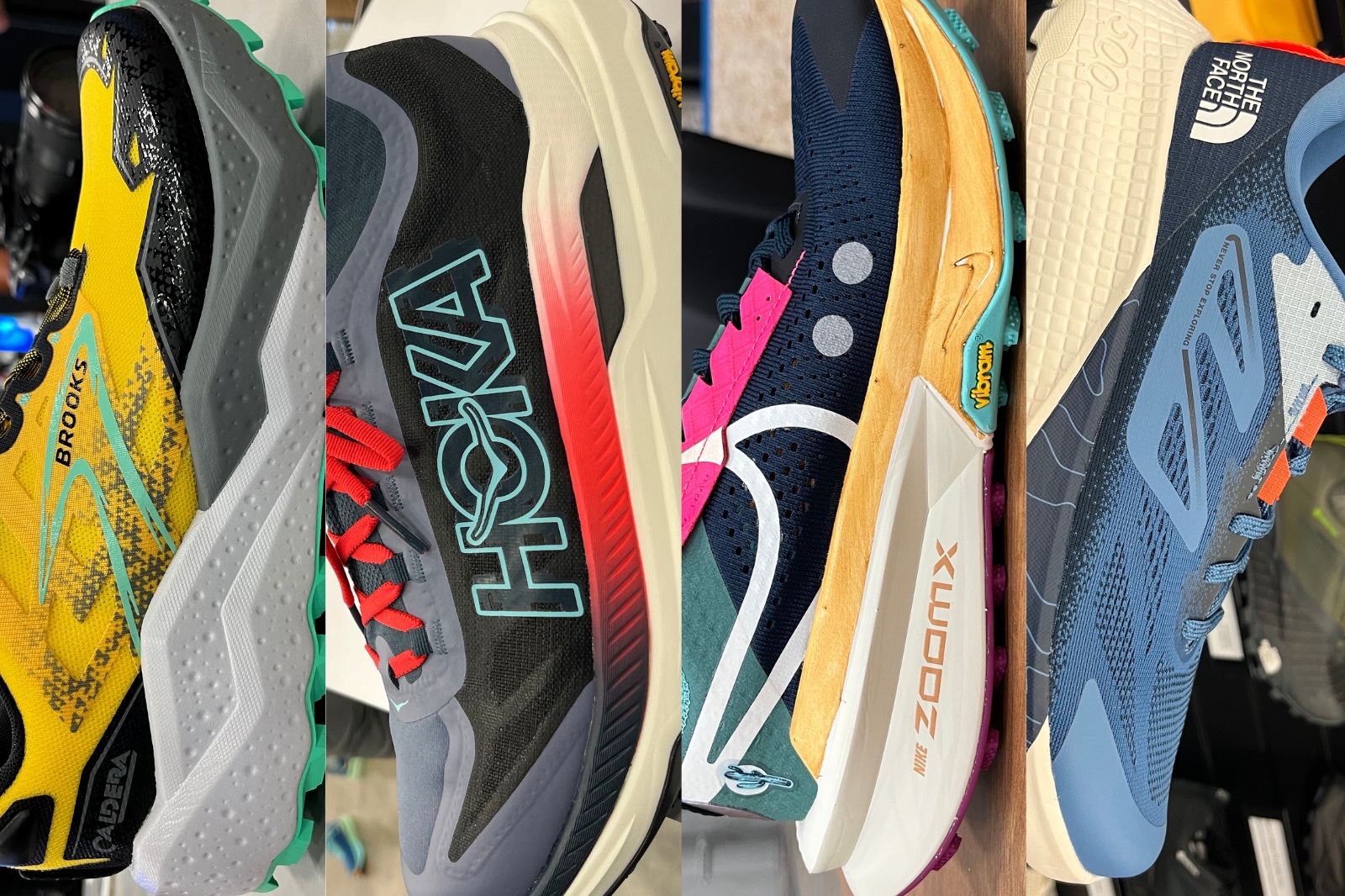
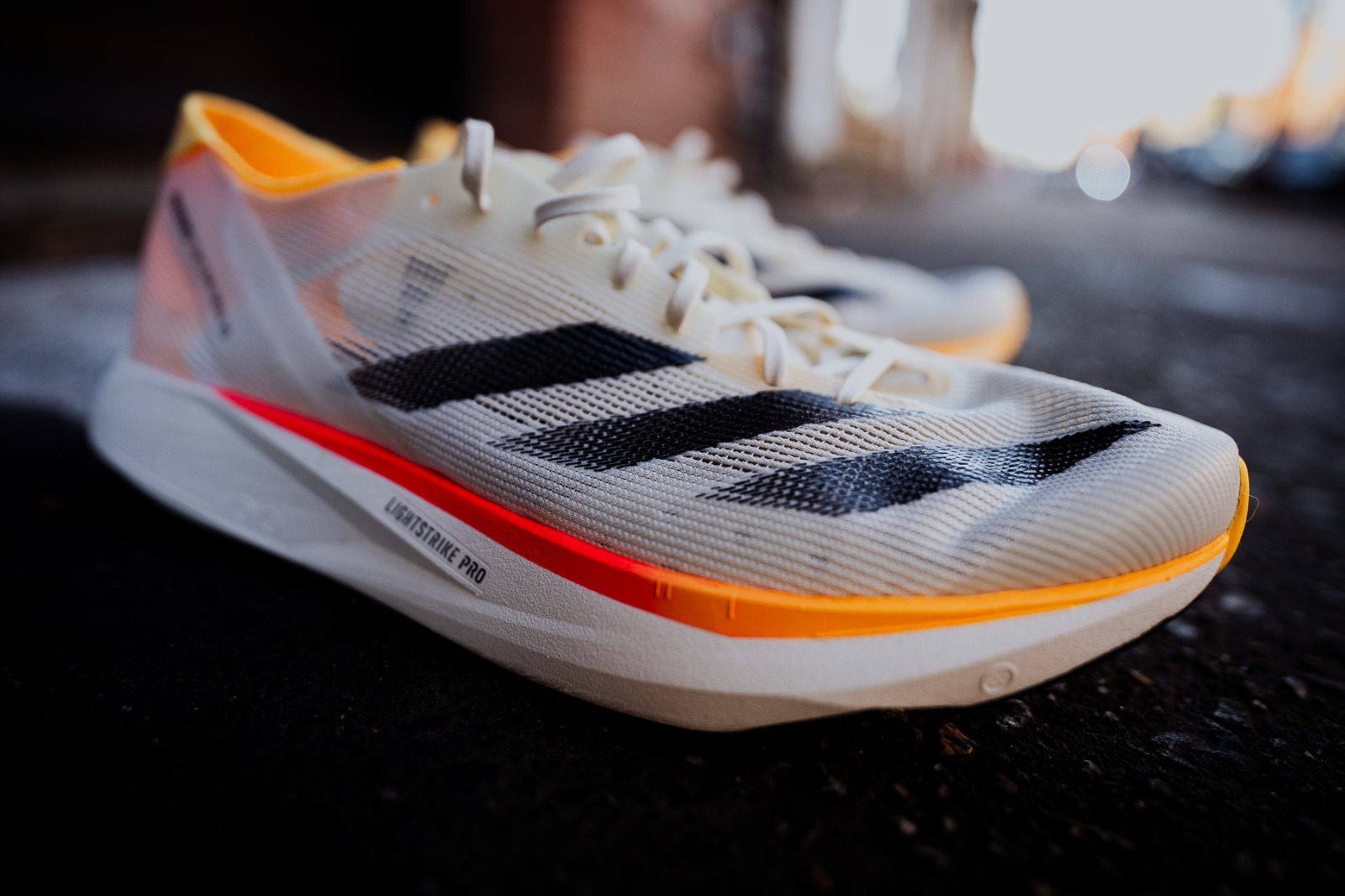
I would love to hear from slower runners testing this shoe. I will try to run a 4:30 marathon in March, but I’m not confident I have that time in me and it will be my 8th marathon. I’m a 2000+km a year runner so It’s not like I’m missing the mileage for it, it’s more a question of, do I have the speed at my age and in my physical condition, is my core strong enough to sustain me for 4 hours and a half (No)?
I run my last two marathons in puma nitro elite since I absolutely love the shoe when I pick up the pace, they feel like feathers at my feet, but the reality is that I don’t pick up the pace in a marathon, after 30Km or 3+hrs my feet are screaming in pain and everything starts falling apart. Would I actually be faster in running in a slower shoes that supports me better so that I can steady go for the distance? We always say that we can’t bank time in a marathon anyway…
This shoe could be an interesting proposition, I have hard time understand how an elite shoe would work for me when I have to go easy for the distance because I never experienced that, sure a 5K in an alphafly, a 10K in a Puma Type-R, even an half marathon in the deviate nitro elite 2, they are all-in race when I feel the propulsion of foam+plate, but if I have to run a race easy for 32km before picking up the pace should I not run on a easy shoe for 32km and switch to a super shoe for the last 10km? And since we can’t swap shoes in a race would the Salomon S/Lab Spectur a big help for slow runner like me?
Beside the fact that at that price is not worth it when you can get most of the super shoe on sale for 120-150€ now, Salomon need to rethink their price strategy.